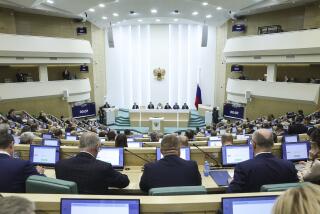U.S., Soviets End Test-Verification Talks; Broad Progress Cited
- Share via
WASHINGTON — U.S. and Soviet negotiators Tuesday completed five months of talks that chalked up unprecedented progress toward verifying agreements limiting nuclear tests, U.S. officials said. The achievements included exchange of detailed data, the first ever provided by the Soviet Union, on five large nuclear blasts conducted by each side since 1978.
Preparations are now almost completed for Soviet personnel to monitor a U.S. test blast in Nevada with their own equipment--in an experiment now scheduled for Aug. 17--and for U.S. experts to verify a Soviet shot in Kazakhstan a month later, U.S. Ambassador C. Paul Robinson told the House Foreign Affairs Committee.
The two sides remain divided on how many on-site inspections of each other’s territory will be permitted, U.S. officials said. But Robinson, who heads the U.S. delegation at nuclear test talks with the Soviet Union, noted the remarkable degree of cooperation between the two nations, “with technical experts now working on the once-forbidden confines of each other’s test sites,” as a measure of their desire to resolve differences.
As another example of the “unprecedented cooperation,” Robinson said, the United States flew seven large planeloads of drilling equipment to the Soviet test site, at Moscow’s request. The Soviets admitted that they could not drill a so-called “satellite” hole, for instruments, with sufficient precision to accurately measure the test blast.
In another arms control development, a White House national security group decided Tuesday to send an unusually high-level delegation to a review conference on the 1972 U.S.-Soviet Anti-Ballistic Missile Treaty to emphasize U.S. demands that the Soviets eliminate violations of the treaty, it was learned. The United States will propose that the conference take place the last two weeks of July, according to U.S. officials.
The United States will call for destruction of the half-completed phased-array radar near Krasnoyarsk, in Siberia. The Soviets have largely admitted the construction to be a mistake by suspending work on the 10-story-tall buildings, but the Administration wants the structures’ shells destroyed so they cannot be equipped later, officials said.
The United States also will call on the Soviets to destroy some old, mobile radar units that were transported to Gomel, a city in the Ukraine some 350 miles south of Moscow. The treaty restricts such units to established missile test ranges beyond the Ural Mountains.
The U.S. team will be led by William F. Burns, new director of the Arms Control and Disarmament Agency, and will include several relatively high-ranking officials. In contrast, previous review conferences met every five years and were conducted by the U.S.-Soviet Standing Consultative Commission that was set up by the treaty for hearing complaints.
The Geneva talks on nuclear testing have moved the two sides materially closer since February to ratification of two U.S.-Soviet agreements limiting underground nuclear explosions to 150 kilotons. Tests in the atmosphere, oceans and space are prohibited.
Those agreements, signed in 1974 and 1976, are called the Threshold Test Ban Treaty and the Peaceful Nuclear Explosions Treaty, respectively. The threshold pact deals primarily with military tests, while the other treaty covers civilian use of nuclear blasts. (Unlike the United States, the Soviet Union has made considerable use of atomic bombs to dig canals, create dams and put out oil-field fires, U.S. officials said.)
The treaties were never ratified. The Carter Administration believed that they did not go far enough, while the Reagan Administration thought that they went too far, claiming they could not be adequately verified.
The log jam gradually has given way over the last two years, particularly since the December summit meeting when Reagan and Soviet leader Mikhail S. Gorbachev agreed to Joint Verification Experiments--one in each country--to demonstrate “the effectiveness, practicability and non-intrusiveness” of on-site inspection methods.
More to Read
Sign up for Essential California
The most important California stories and recommendations in your inbox every morning.
You may occasionally receive promotional content from the Los Angeles Times.













